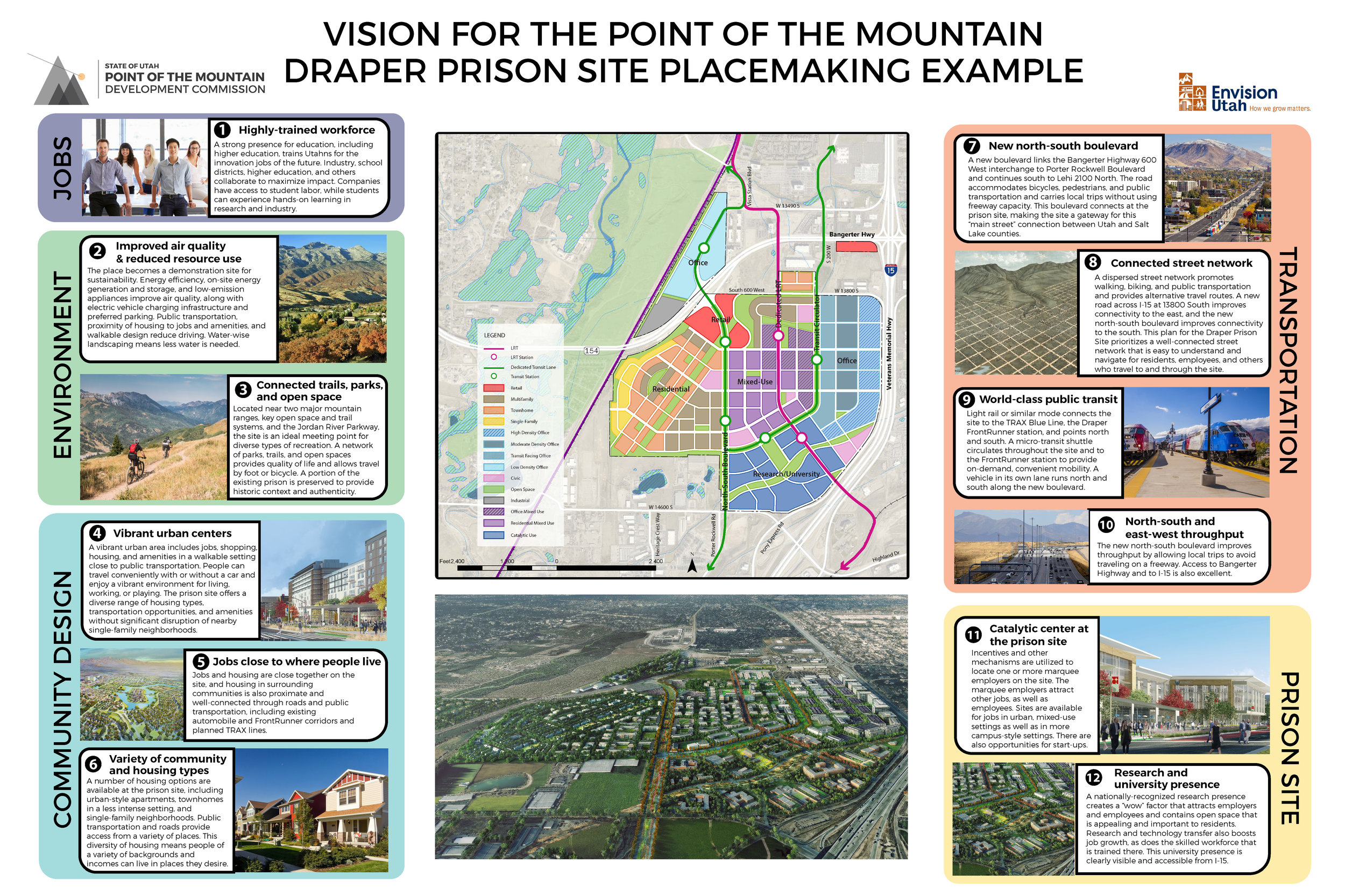PHASE TWO OVERVIEW
The Point of the Mountain Development Commission and the Envision Utah-led project team have just finished phase two Point of the Mountain Visioning Process. Phase One of the effort focused on listening to Utahns. Phase Two involved evaluating potential scenarios for the years to come, and bringing together stakeholders and the public to decide what elements of those scenarios they want to work towards. The main goal of Phase Two of the process is to model different scenarios for the region and to present these scenarios to the public and stakeholders who will help establish one preferred vision that reflects their desires for the area.
Near the start of Phase Two, the Point of the Mountain Development commission and consultant team began meeting with Small Advisory Groups comprised of a wide variety of stakeholders with the aim of tackling specific topics crucial to the future of the Point of the Mountain. With the help of these Small Advisory Groups, the consultant team formed an understanding of the scope of topics that would need to be addressed by the vision and illustrative scenario for it to be impactful and effective.
The consultant team and the Point of the Mountain Commission Co-chairs met with regional transportation agencies and local cities at key points through Phase Two of the process to gain the information and perspective necessary to include variables and metrics that would be significant and realistically implementable when proposing the vision and illustrative scenario to the legislature.
Building off of the input of the Point of the Mountain Development Commission, Small Advisory Groups, regional transportation agencies, and other developers, residents and business owners, the consultant team developed five scenarios exploring different ways the Point of the Mountain may develop, split into eight key topic areas that differ with each scenario. These alternative scenarios were shared with stakeholders and the public to receive feedback on their impacts on the key measures that were identified as most important throughout Phase One, both through in-person meetings in late November and through a month-long outreach period where residents were able to learn about individual scenarios and cast their votes at pointofthemountainsurvey.org. The specific details of this survey and outreach effort are contained in the following sections.
An illustrative map showing some of the concepts contained in the Point of the Mountain Vision, including the 12 signature elements.
With the results of this outreach, the consultant team and Commission Co-chairs met with local cities and regional transportation agencies at the end of December to begin to iron out a preferred scenario that combines different aspects of scenarios based on those voted for in the survey outreach process. Over the next month, this preferred scenario took shape and was vetted by local cities, transportation agencies, and other stakeholders and has now been released and presented to the Utah State Legislature for their consideration in the upcoming session.
The preferred vision includes:
- A regional vision map
- A detailed map showing the Draper prison site as an example of the twelve signature elements
- A shorter, summary report
- A longer, more detailed report
- Appendix materials including consultant reports, meeting notes, and public comments
A site plan detailing how the Draper prison site could be an example of the 12 signature elements contained within the Point of the Mountain vision.
THE VISION
The vision is distilled down to twelve signature elements with goals, strategies, and short-term tasks designed to help guide the Point of the Mountain towards the future chosen by residents throughout the process to date. The twelve signature elements of the vision are:
- A deep, diverse, and highly-trained workforce
- Improved air quality and natural resource use
- A connected network of trails, parks, and open space
- Vibrant urban centers
- Jobs close to where people live
- A variety of community and housing types
- A new north-south boulevard
- A connected street network
- World-class public transportation
- North-south and east-west throughput
- A catalytic job core & urban center at the prison site
- A nationally-recognized research and university presence
For more information about these signature elements, maps of the vision, and other materials, refer to the Phase 2 Report:
The vision was first presented to the Point of the Mountain Development Commission and released to the public on January 22nd, 2018.
Phase 3 is expected to begin soon after the publication of the preferred scenario, and will explore ways to fund the needed infrastructure and economic development to make the preferred scenario a reality.
An HOK rendering of a bustling office center at the Draper prison site.





